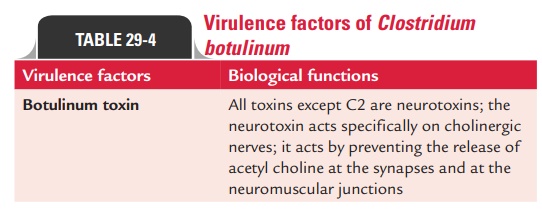Chapter: Microbiology and Immunology: Bacteriology: Clostridium
Pathogenicity and Immunity - Clostridium botulinum
Pathogenicity and Immunity
C. botulinum organisms are noninvasive. They cause diseaseprimarily by production of an exotoxin, the botulinum toxin, which is the major virulence factor of the bacteria (Table 29-4).

◗ Virulence factors
Botulinum toxin: Botulinum toxin is a protein with molec-ular weight of 70,000 Da. The toxin is relatively heat stable. It is inactivated at 80°C for 30–40 minutes and at 100°C for 10 minutes. The toxin is similar in structure and function to the tetanus toxin, except only in the site of action.
· Botulinum toxin differs from other exotoxins in that it is produced only on death and autolysis of the bacteria, but not when the bacilli are alive.
· Botulinum toxin is a progenitor protein synthesized intra-cellularly in the bacteria. It consists of two subunits A and B.
Subunit A is the light chain and is a neurotoxin. Subunit B is heavy chain, which prevents neurotoxin part (chain A) from being inactivated by acidity of the stomach. More than three B subunits may be present in the toxin.
· Botulinum toxin is the most potent naturally occurring toxin known to mankind.
· The lethal dose for mice is 0.000,000,033 mg and for human beings is 1–2 g. Botulinum toxin is lethal at a femto-molar level of doses of 10 12 g/kg, making botulinum toxin 15,000–100,000 times more potent than serin gas.
· The toxin can also be toxoided.
Depending on the immunological differences in the toxins pro-duced by C. botulinum, eight antigenically distinct botulinum toxins (types A, B, C1, C2, D, E, and F, G) have been described. These different toxins appear to be identical in their biological functions but differ immunologically. The toxins are specifi-cally neutralized only by their homologous antiserum.
· A single strain of bacteria produces only one toxin.
· In rare instances, a single strain may produce more than one toxin. All toxins except C2 are neurotoxins.
The neurotoxin acts specifically on cholinergic nerves. It acts by preventing the release of a neurotransmitter, acetylcholine, at the synapses and at the neuromuscular junctions. It causes atrophy of the muscles at the site of the infection, but the neu-rons regenerate in 2–4 months of recovery.
Toxins A and B are the most potent toxins. The production of toxins by C. perfringens types C and D appears to be mediated by bacteriophages.
◗ Pathogenesis of botulism
Botulism is caused in various ways:
· Food-borne botulism is caused by direct ingestion of botuli-num toxin in a contaminated food.
· Infant botulism is caused by toxins produced by C. botulinum present in the intestine.
· Wound botulism is caused by toxins produced in a C. botuli-num contaminated wound.
From the stomach and small intestine, toxins are absorbed, as they are not denatured by digestive enzymes. The toxin enters the vascular system and is transported to peripheral cholinergic nerve terminals, such as neuromuscular junctions, cholinergic parasympathetic nerve endings, and some peripheral ganglia.
The toxin binds to receptor sites on presynaptic motor nerve terminals and causes blockade of neuromuscular con-duction. The toxin then enters the nerve terminal and inhibits the release and transmission of acetylcholine in cholinergic nerve fibers. The toxin irreversibly binds to the neurons.
The nervous, gastrointestinal, and endocrine-metabolic systems are mainly affected. Because the motor end plate responds to acetylcholine, ingestion of botulinum toxin results in hypotonia, manifesting as descending symmetric flaccid paralysis of the respiratory muscles.
Related Topics